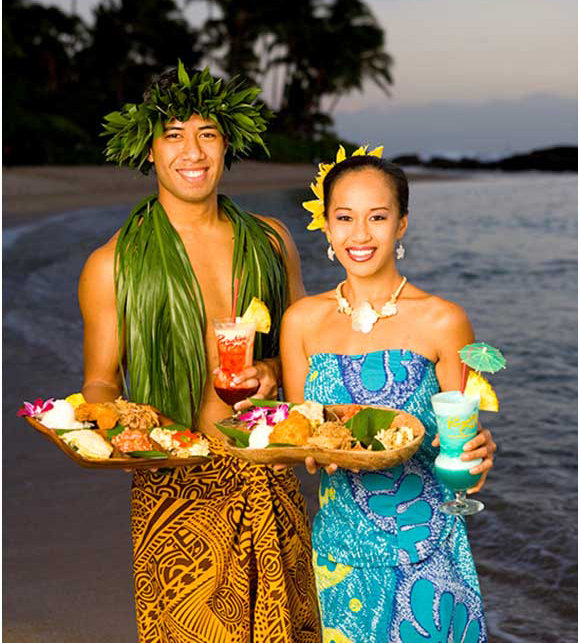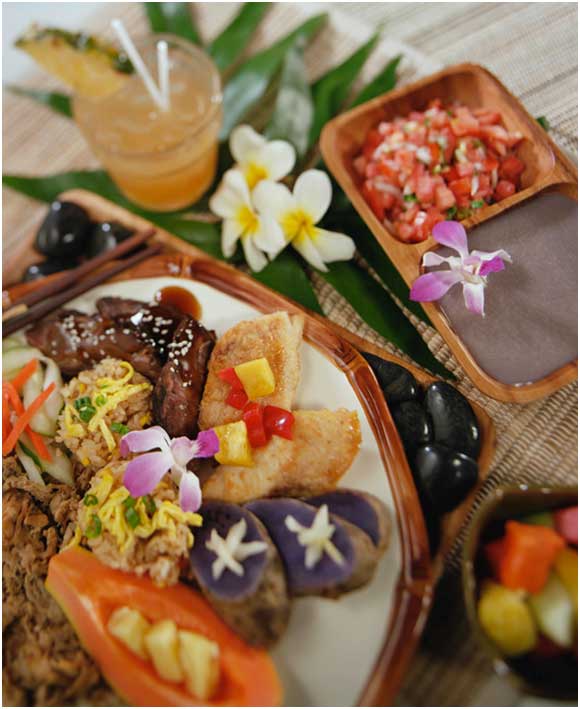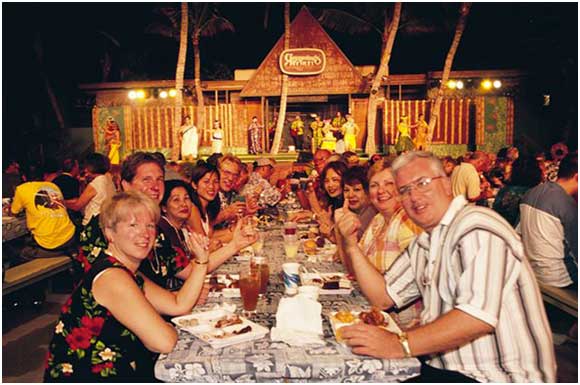LOCO FOR LUAU

Photo by: Paradise Cove Luau (Oahu)
When visiting Hawaii one of the best ways to get a taste for the islands is to tuck into a traditional Hawaiian spread or luau (pronounced lu-wow). Unlike conventional dining, luaus offer more than just a delicious buffet, but a feast for your eyes – such as song and hula – and the spectacle of seeing how your food is prepared, fresh from the imu (underground oven).
When planning your next visit to the islands, leave some time in your schedule to get familiar with Hawaii’s home cooking. Because Hawaiians really know how to put the wow in luau.

Photo by: Alii Luau (Oahu)
The legacy of luau
Today the tradition of luau is common place across the islands and is used as a way to celebrate a number of occasions – from a baby’s first birthday, a wedding or high school graduation. But this tradition traces back to the 1800s where Native Hawaiians marked special occasions with aha aina (translated aha means gathering and aina means meal). These significant feasts were cooked up to celebrate special occasions, which included everything from a war victory, the completion of a new canoe or a successful hunt.
Then, luau was eaten on the floor on lauhala (leaves from the hala tree) mats. Without utensils, guests enjoyed the meal with their fingers. While these meals were festive, there were specific foods that were off limit to commoners and women, including delicacies such as moi (a local reef fish), pork and bananas.
In 1819 King Kamehameha II ended the traditional practice of men and women dining separately by eating openly with women. It was shortly thereafter that the term aha aina was replaced with luau – a name which evolved from the popular menu item of young taro tops baked with coconut milk and chicken or octopus legs.
The pomp and pageantry of today’s luau wane in comparison to those of Hawaii’s alii (royalty) of old. King Kamehameha’s luau in 1847 featured an overflowing menu which included 2,245 coconuts, 4,000 taro plants, 482 bowls of poi, 3,125 salted fish, 1,820 fresh fish and 271 hogs.

Photo by: Smith Family Garden Luau (Kauai)
What’s on the menu
Many of the items on a luau menu are as rich with symbolism to Native Hawaiians as they are delicious to the local palate. In fact, the luau menu – as with the entire tradition and practice of luau – was designed to bring participants together. Certain menu items represent strength, while other delicacies indicated virtues or goals diners hope to achieve by imbibing them.
Before digging into your dinner, brush up on some of the entrees typically found on the menu:
- Poi: Made from mashed taro, poi is a viscous starch dish.
- Kalua pig: Traditionally one of the main attractions at a luau, kalua pig consists of pork shoulder or pork butt rubbed with sea salt and roasted in an imu.
- Poke: Meaning “to slice or cut” in Hawaiian, poke is raw, cubed fish or seafood (typically ahi) that has been marinated with sea salt, soy sauce, seaweed and other ingredients.
- Lomi salmon: A popular luau side dish, lomi salmon is prepared by lomi-ing (massaging) raw salted salmon, tomatoes and onion.
- Lau lau: A traditional Hawai‘i dish also prepared in an imu, lau lau consists of pork, chicken or fish wrapped in taro leaf, wrapped in a ti leaf.

Photo by: Germaine’s Luau (Oahu)
A tip or two
Before heading out (and donning that coconut bra and grass skirt ensemble) here are some quick tips for getting your luau on.
- Attire: Dress for a luau is considered “Hawaiian casual” which means aloha shirts and slacks or nice dress shorts for men and a casual dress or aloha wear for women.
- Tipping: Tips are not typically included in the price of the meal. Think about providing gratuity for your waiter or table host if their service deserves acknowledgement.
- Reservations: Luaus typically fill up quickly – to get the best seats reserve well in advance.
- Special Accommodations: If you require special seating for handicapped guests or have dietary restrictions, plan to book well in advance and ask what special arrangements they can accommodate.
